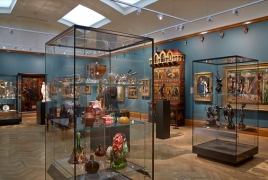
On 13 May the Ashmolean opens to the public its newly refurbished and redisplayed galleries of Nineteenth-Century Art in the Museum’s historic Cockerell Building, Art Daily reports. The project has been made possible by a major gift from U.S. collectors Barrie and Deedee Wigmore. The Wigmores’ support has facilitated the refurbishment of the galleries and the installation of new environmental controls; provided funding for a Curator of Nineteenth-Century Decorative Arts; and they are making a gift of some of the important ceramics from their collection. The new scheme has also allowed the Museum to return from long-term loan and put on display the most important example of Victorian painted furniture ever made, the Great Bookcase designed by William Burges and decorated by Pre-Raphaelite painters.
Based in New York City, Mr and Mrs Wigmore have been long-term collectors of late-nineteenth century paintings, furniture, metalwork and ceramics. Mrs Wigmore is the President of D Wigmore Fine Art Inc. Mr Wigmore, a retired partner of Goldman Sachs, is an expert on financial history and the author of numerous books and articles. The Wigmores were both at Oxford in the 1960s, and both are honorary fellows of Worcester College, Oxford. Mr Wigmore is also a Trustee of the Metropolitan Museum, New York.
The Museum’s world-famous collection of nineteenth-century paintings, works on paper and sculpture, in particular works by the Pre-Raphaelites has lacked nineteenth-century decorative arts. The Wigmores’ gift of British ceramics will form the nucleus of a growing collection of nineteenth-century decorative arts. The gift includes important pieces by Christopher Dresser (1834–1904) for Linthorpe, Ault, Minton and Wedgwood and major works by the Martin brothers (1873–1923).
The Wigmores’ gift has also enabled the Museum to install much needed environmental controls in the historic galleries and has provided new display cases allowing Victorian ceramics, metalwork, and glass to be shown in the same galleries as painting and sculpture for the first time. This includes a spectacular new seven metre display case for ceramics on long-term loan to the Ashmolean from the De Morgan Foundation.
The redevelopment of the galleries has afforded the Museum the opportunity to reorganize the display of the collection. The decision was taken to move the PreRaphaelite paintings into the largest gallery to be shown with other important Victorian works including exceptional paintings by Lord Leighton, William Dyce and James Tissot. Nineteenth-Century British and French landscapes including works by Corot, Turner and Samuel Palmer are now shown in the more intimate surroundings at the end of the suite of galleries.
This change was partly dictated by the return to the Museum, after an absence of over 60 years, of the Great Bookcase. Standing at over three metres tall, this unique piece of gothic revival furniture was designed by the architect William Burges (1827–81) to hold his collection of books on art and architecture. Between 1859 and 1862, Burges commissioned fourteen artists, most of whom were associated with the Pre-Raphaelite Movement, to paint the bookcase with scenes depicting the Pagan and Christian Arts. They included Edward Burne-Jones, Stacy Marks, Albert Moore, Edward Poynter, Dante Gabriel Rossetti and Simeon Solomon. The bookcase formed the centrepiece of the ‘Medieval Court’ at the International Exhibition held in London in 1862.
Described as the most important example of Victorian painted furniture ever made, this remarkable object was acquired for the Ashmolean by Kenneth Clark in 1933 for the relatively modest sum of £50. It was a farsighted acquisition at a time when most Victorian art was widely mocked and derided. Clark wrote that ‘though not acceptable to present taste it will always remain an important document in the history of the [Pre-Raphaelite] movement’. Clark almost certainly acquired the bookcase so that it could be displayed with the Museum’s Pre-Raphaelite paintings. In 1952, however, it was lent to a pioneering exhibition on Victorian and Edwardian decorative arts at the V&A. The bookcase remained on loan in Kensington for many years before being lent to Knightshayes Manor in Devon in the 1980s. There it remained until last year when it was decided that it should return to Oxford to take its rightful place with the Ashmolean’s Pre-Raphaelite paintings as Kenneth Clark had originally intended over 80 years ago.
Mr Matthew Winterbottom, Barrie and Deedee Wigmore Curator of Nineteenth-Century Decorative Art, Ashmolean Museum, says: ‘The Victorian age was one of the most exciting and creative periods in British history. After many years of neglect and often outright hostility attitudes have changed. The Great Bookcase would no longer be described as ‘not acceptable to present taste’ and our Pre-Raphaelite paintings are among the Ashmolean’s most loved exhibits.’
Dr Alexander Sturgis, Director of the Ashmolean, says: ‘Barrie and Deedee Wigmore’s extraordinary generosity has allowed the Ashmolean to revitalize the Nineteenth-Century Galleries – one of the most popular parts of the Museum. The gift of some of their most important ceramics has also extended the scope of our collection; and their support for a curator of Nineteenth-Century Decorative Art will allow us to build on this part of the collection and develop ways of bringing it to a wide public audience.’

